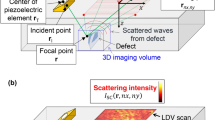Abstract
The creation of a non-destructive technique that enables the automatic detection of defects is desirable, and TOFD (Time-Of-Flight Diffraction) technique is gaining rapid prominence due to its high accuracy in detecting, positioning and sizing flaws in steel structures. In this type of imaging, cracks are characterized using sets of hyperbolas, where summit positions correspond to crack tip positions. However, ultrasonic diffracted signals are often too low and difficult to distinguish from noise, and when large structures are inspected, the quantity of data can be extremely large, with the area of interest being very small in comparison to the image size. This paper describes a method that avoids the image formation, replacing it with a sparse matrix (as there is no reason to store and operate on an excessive number of zeros), and automates crack detection by analyzing the curve formed by the sparse matrix elements. The sparse matrix is formed using Split-Spectrum Processing, which enhances the signal-to-noise ratio. The Randomized Hough transform is then applied on the sparse matrix elements to detect the hyperbolas that characterize the crack defects.
Similar content being viewed by others
References
Shuxiang, J.: Development of an automated ultrasonic testing system. In: 3rd International Conference on Experimental Mechanics, Singapore, 2004. SPIE Proceeding, vol. 5852. SPIE, Bellingham (2004)
Bavendiek, K., Herold, F.: Defect recognition in industrial applications. In: Proceeding of International Workshop of Imaging in NDE, INDE, Hamburg, Germany (2007)
Baker, A.R.: The classification of defects form ultrasonic data using neural networks: the Hopfield method. NDT Int. 22(1), 97–105 (1989)
Webber, S.A.: Five years of testing using the semi-automated ultrasonic time of flight diffraction system. In: 10th APCND, Austria (2001)
Miller, M.: Development of automated real-time data acquisition system for robotic weld quality monitoring. Mechatronics 12(9–20), 1259–1269 (2002)
Passi, G.S.: Reducing the influence of human factors on the reliability of manual ultrasonic weld in inspection. Insight 37(10), 788–791 (1995)
Martin, J., Gonzalez, R.: ULTRASCOPE TOFD: un sistema compacto para la captura y procesamiento de imagine TOFD. In: IV Conferencia Panamericana, de END, Buenos Aires (Oct. 2007)
Swamy, G., Baskaran, G.: A point source correlation technique for automatic discontinuity identification and sizing using time of flight diffraction. Mater. Eval. 63(4), 425–429 (2005)
Baskaran, G., Balasubramanian, K.: Ultrasonic TOFD flaw detection sizing and imaging in thin plates using embedded signal identification technique (ESIT). Insight 46(9), 537–542 (2004)
Robini, N.C., Magenin, I.E.: Two-dimensional ultrasonic flaw detection based on the wavelet packet transform. IEEE Trans. Ultrason. Ferroelectr. Freq. Control. 44(6), 1382–1394 (1997)
Lawson, S.W., Parker, G.A.: Automatic Detection of Defects in Industrial Ultrasound Images Using Neural Networks. Proceeding of SPIE, vol. 2786, pp. 37–47. SPIE, Bellingham (1996)
Shekhar, C., Shitole, N.: Combining fuzzy logic and neural networks in classification of weld defects using ultrasonic time of flight diffraction. In: 45th Annual British Conference on NDT, NDT 2006, Stratford-upon-Avon, UK (September 2006)
da Silva, I.C., Siqueira, M.H.S.: Automatic inspection using the TOFD technique and neural networks. In: 8th European Conference in Non Destructive Testing, ECNDT, Barcelona (2002)
Maitre, H.: Un panorama de la Transformée de Hough. Rev. Trait. Signal. 2(4), 305–317 (1985)
Von Lew Yan, L.F.C.: Gradient based hough transform for the detection and characterization of defect during non destructive inspection. In: Proceeding of Symposium on Electronic Imaging Science and Technology, vol. 3029, pp. 140–141, California (1997)
Maalmi, K.: Crack defect detection and localization using genetic-based inversion voting hough transform. In: 16th International Conference in Pattern Recognition ICPR’02, vol. 3, Quebec City, (11–15 Aug. 2002)
Merazi Meksen, T., Drai, R.: Pattern recognition in ulrasonic imagery using the hough transform. In: Proceeding of World Conference of Ultrasonics WCU2003, Paris (Sept. 2003)
Yau, K.K.: Split spectrum processing for non destructive testing, NDTnet, No08. http//%20www.ndt.net/article/splitspec (Aug. 1999)
Xu, L., Oja, E.: Randomized hough transform (RHT) basic mechanisms. Algorithms Comput. Complex., Image Underst. 57(2), 131–154 (1993)
Author information
Authors and Affiliations
Corresponding author
Rights and permissions
About this article
Cite this article
Merazi Meksen, T., Boudraa, B., Drai, R. et al. Automatic Crack Detection and Characterization During Ultrasonic Inspection. J Nondestruct Eval 29, 169–174 (2010). https://doi.org/10.1007/s10921-010-0074-4
Published:
Issue Date:
DOI: https://doi.org/10.1007/s10921-010-0074-4




